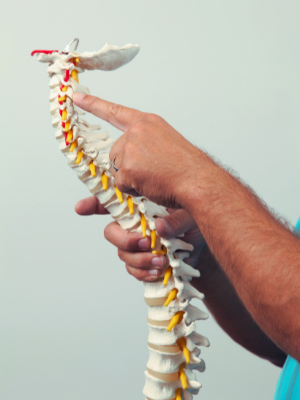Types Of Neck Pain
- Updated - April 25, 2025
The joints in your body are intricately designed to support effortless movement. However, abnormalities in these joints, especially in the neck, can lead to various types of neck pain that can disrupt daily life.
The neck, or cervical spine, is composed of seven vertebrae connected by small facet joints, allowing you to turn your head from side to side. This complex structure of bones, muscles, and joints supports essential movements, from lifting and bending the head to facilitating clear airways for breathing, swallowing, and speaking. Given its central role, even minor issues in the neck can cause significant discomfort, impacting everything from mobility to routine tasks.

Understanding Neck Pain
Neck pain is a common condition that affects millions of people worldwide, ranging from mild discomfort to severe pain that can disrupt daily activities. Various factors contribute to neck pain, including poor posture, muscle strain, and spinal degeneration. Understanding the underlying causes is crucial for developing an effective treatment plan.
Neck pain can be classified into different types, each with distinct characteristics. Axial neck pain is localized to the neck, often resulting from muscle strain or poor posture. Muscle spasms can cause sudden, intense pain and stiffness, making it difficult to move the neck. Referred pain occurs when pain from another part of the body is felt in the neck, while nerve pain, often due to a pinched nerve, can radiate down the arms and cause tingling or numbness. Recognizing these types can help in identifying the most appropriate treatment approach.
Signs and symptoms of neck pain
Neck pain can vary depending on the underlying cause. However, some general symptoms may include:
- Headache
- Muscle spasms and stiffness in the neck area
- Pain that radiates down the arms or shoulders
- Neck pain that gets worse when you move your head or neck
- Decreased range of motion in the neck area
- Tingling or numbness in the arms or hands
- Dizziness or light headedness
Chronic neck pain may stem from conditions such as herniated discs or degenerative spine issues. Individuals suffering from chronic neck pain should seek medical advice to explore various treatment strategies.
Muscle pain can result from muscle strains, sprains, and tears, leading to neck pain. Proper posture and ergonomic practices are crucial to prevent and alleviate muscle pain.
Below are a few instances of what can occur when things go wrong. While not an exhaustive list, it does provide some clues as to common issues arising from different types of neck pain.
1. Muscular Pain / Spasm
2. Neck (Cervical) Joint Pain
The cervical vertebrae are the top seven bones in the spinal column that form your neck. Facet joints link the bones together. These are tiny joints between your vertebrae that, together with your neck muscles (including deep neck muscles), allow you to move your head in any direction.
The joints that act to allow your neck to move are the facet joints. The facets themselves are bony surfaces that face each other when you move your head in different ways. This is part of how they allow us to move our heads in any direction. However, when the joint surfaces aren’t correctly positioned, this can lead to damage and pain.
Inflammation or compression near nerve roots can lead to various sensations such as sharp pain, burning, and ‘pins and needles’.
Deep, sharp, and aching pain is felt when these joints are injured, or arthritic deterioration occurs. When pressure is applied to the joint with neck movement, this discomfort typically intensifies. This pain may also spread to your shoulder or upper back, sending misery throughout your entire upper body.
3. Referred Pain
Pain that begins in one region of your body but is felt somewhere else is known as referred pain. You may also get neck pain if an issue in another area of your body causes it.
If you experience discomfort only when performing a certain activity or pressing on a specific region of your body, this is referred pain, and it may be necessary to visit an expert to determine whether you have any underlying concerns.
Discover a practitioner near you.
Looking for a practitioner near you? Our extensive network of qualified professionals is here to help you.
4. Bone (Cervical Vertebra) Pain
The soft tissue structures of the neck (cervical spine) are the most common cause of neck pain. However, it’s possible for bones to be painful, albeit less frequently, than soft tissue problems. Pain and soreness in the cervical vertebras are far less prevalent than neck discomfort caused by soft tissues. However, it is still severe enough to require immediate medical attention.
5. Headache

Occasionally, a headache might give you neck pain. A stiff neck can result from muscle spasms and cause pain, tightness, and restricted movement.
Headaches caused by muscular tension or spasms in the neck can be felt in the back of the head and upper neck. It’s typically more of a dull ache or ‘throbbing’ pain that may be accompanied by tenderness or stiffness.
You may also experience a limited range of motion – such as found with too much mobile device usage (Text Neck).
6. Injuries

WHIPLASH is a common neck-related injury. It can occur when your head rapidly moves in one direction and then back. For instance, if you’re driving your car and someone strikes you from the rear, this could be the case. Whiplash does not always present immediately; in fact, it may take time for you to notice anything. However, if left untreated, whiplash can cause nerve discomfort and headaches.
7. Nerve Pain / Nerve Pain Irritation

If a nerve in your neck becomes irritated, you could feel pain, numbness, or tingling down the length of the arm (including hand and fingers). While difficult to describe, pain attributed to pressure on the nerve as it exits the spinal cord can lead to a ‘pinched’ nerve, leading to impingement or irritation at the nerve root. As pressure on the nerve at the joint increases, the more discomfort, pain, and local changes can be felt.
Axial pain is a common type of neck pain that is localized, does not radiate, and can feel dull, achy, or throbbing.
The key to keeping neck pain manageable is early recognition and appropriate treatment. Neck issues should not be ignored as they can lead to more serious health problems if left untreated!Posture GeekTweet
The key to keeping neck pain manageable is early recognition and appropriate treatment. Neck issues should not be ignored as they can lead to more serious health problems if left untreated!
Posture Geek Tweet
Diagnosing and Managing Neck Pain
Diagnosing neck pain often starts with gathering a comprehensive medical history and conducting a physical examination. Healthcare providers focus on excluding serious conditions such as spinal cord pressure, myelopathy, infections, or cancer. In certain situations, further tests like imaging studies, blood tests, or electromyography (EMG) and nerve conduction studies (NCS) might be needed to determine the exact cause.
Once the underlying cause is identified, a tailored treatment plan can be developed. The primary goals are to relieve pain and improve neck mobility. Many cases of neck pain improve with home management, including over-the-counter pain relief medications, physical therapy, chiropractic care, and massage therapy. Lifestyle modifications, such as improving posture and incorporating regular exercise, also play a significant role in managing neck pain effectively.
Preventing Neck Pain
Preventing neck pain involves a proactive approach that includes maintaining good posture, engaging in regular exercise, and managing stress. Strengthening the upper back extensor muscles through exercises like shoulder rolls, chest stretches, neck stretches, and upper back strengthening routines can significantly reduce the risk of neck pain.
Improving posture, especially during activities like sitting at a desk or using a mobile device, is crucial. Taking regular breaks to stretch and move throughout the day can prevent stiffness and muscle strain. Additionally, maintaining a healthy weight, quitting smoking, and avoiding heavy lifting can further reduce the likelihood of developing neck pain. By incorporating these habits into your daily routine, you can effectively prevent neck pain and maintain a healthy, pain-free neck.
When to Seek Medical Attention

While many cases of neck pain can be managed at home, certain symptoms require immediate medical attention. If you experience severe neck pain, numbness or tingling in your arms or legs, or difficulty speaking or swallowing, seek medical help right away. Other red flags include fever, chills, or a recent injury.
Persistent or worsening neck pain or the appearance of unusual symptoms like weakness or paralysis also warrants a visit to a healthcare provider. A professional can help determine the underlying cause of your pain and develop an effective treatment plan to alleviate your symptoms and improve your quality of life. Don’t ignore severe or persistent neck pain, as it could be a sign of a more serious condition.
Finally
Neck pain can disrupt daily life and range from mild discomfort to debilitating pain. Recognizing the different types of neck pain—whether muscular, joint-related, nerve-based, or referred—is the first step toward effective treatment and prevention.
Taking proactive measures such as maintaining good posture, engaging in regular physical activity, and seeking timely medical guidance can help manage or even prevent neck pain. While some cases of neck pain resolve on their own, persistent or severe symptoms warrant attention from a healthcare provider.
Early diagnosis and intervention can help alleviate discomfort, improve mobility, and ultimately enhance your quality of life.
Please Consider
If any of the above-mentioned neck discomforts sounds like you, you should consider seeking immediate medical attention. While your neck discomfort might be isolated in nature, it’s possible that it’s a sign of a more severe problem. Even if the pain is restricted to one location, an expert medical professional can assist you in determining the source of your discomfort.
PLEASE NOTE
PostureGeek.com does not provide medical advice. This information is for educational purposes only and is not intended to be a substitute for professional medical attention. The information provided should not replace the advice and expertise of an accredited health care provider. Any inquiry into your care and any potential impact on your health and wellbeing should be directed to your health care provider. All information is for educational purposes only and is not intended to be a substitute for professional medical care or treatment.
COMMON POSTURE PATTERNS
About the author
Find Expert Posture Practitioner Near You
Discover our Posture Focused Practitioner Directory, tailored to connect you with local experts committed to Improving Balance, Reducing Pain, and Enhancing Mobility.


